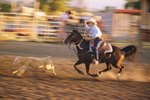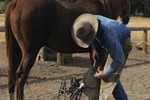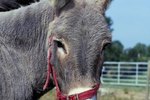Things You'll Need
Hoof pick
Hoof knife
Nippers
Filing rasp
Warnings
Do not cut the inner or outer hoof wall too short. Corrective trimming can be effective, but may take more than one trim to achieve proper length and shape. Do not attempt to trim the hoof wall shorter than the frog or sole. The hoof should be trimmed evenly on either side, and the toe should not be longer than the heel. Trimming around the hoof should generally follow the natural shape of the foot. Cutting the hoof against this natural shape may cause the sole to be tender and the hoof wall to be weakened.
Tips
After initially trimming an overgrown hoof, the heel may still be too long, or too low and the toe too long. If the horse is allowed to go barefoot — that is, without metal shoes — the hoof will most likely reshape itself. Continue regular trims every four to six weeks to maintain proper hoof length. Hoof supplements may also be helpful for horses with weak hoof walls that are prone to flaring.
Any time a horse sustains an injury involving a deep or long cut, especially to the hoof or leg, call a vet.
Healthy hooves are essential to a healthy horse. A variety of serious problems and ailments can arise if a horse's feet are not trimmed on a regular basis. Normally, a horse should receive a trim every four to six weeks, depending on the individual horse and his lifestyle, diet and workload. When dealing with overgrown hooves, which are hooves that have not been trimmed regularly and allowed to grow too long, special attention is required to correct the grown-out hoof wall.
Clean the hoof with a hoof pick. Pick out all the dirt from around the frog and the cracks in the sole. The frog is the soft, spongy area of the horse's foot that extends from the heel to a point in the middle of the sole. Use the hoof pick's brush to sweep out all loose dirt. If the horse is suffering from thrush, treat it before attempting to trim away too much of the hoof.
Use a hoof knife to cut away dead flesh from the sole and frog. Dead flesh is that which is dried out and and loose. Do not cut live flesh, as this is painful and can cause injury to the horse. If you cut live flesh from the sole or frog, staunch the bleeding and immediately call a vet.
Trim the hoof wall with nippers. This will begin to remove the extra length on the overgrown hoof. Keep the nipper blades parallel to the bottom of the hoof. When beginning to cut, start at one side of the foot, at the heel, and trim the wall to the toe. Repeat on the other side, starting at the heel and working to the toe. Take small sections of the wall at a time.
Use the filing rasp to smooth out the cuts made by the nippers and to level off the hoof. Working from heel to toe, carefully file the hoof wall to make both sides level. The rasp should make contact with both sides of the foot at one time to ensure even filing. Round the outer wall to get rid of jagged edges. Check the hoof for an even cut that is not too deep after every few strokes.
Remove flaring in the hoof by rasping the outside of the foot. For dished out or flared feet, the initial filing will help correct the problem, but do not try to rasp away the entire flare during the first trim. Correcting dished out feet will take time; rasping too much of the outer wall makes it weak and can be painful. The white line of the hoof should be used as a guide when rasping and filing.
References
Resources
Tips
- After initially trimming an overgrown hoof, the heel may still be too long, or too low and the toe too long. If the horse is allowed to go barefoot --- that is, without metal shoes --- the hoof will most likely reshape itself. Continue regular trims every four to six weeks to maintain proper hoof length. Hoof supplements may also be helpful for horses with weak hoof walls that are prone to flaring.
- Any time a horse sustains an injury involving a deep or long cut, especially to the hoof or leg, call a vet.
Warnings
- Do not cut the inner or outer hoof wall too short. Corrective trimming can be effective, but may take more than one trim to achieve proper length and shape. Do not attempt to trim the hoof wall shorter than the frog or sole. The hoof should be trimmed evenly on either side, and the toe should not be longer than the heel. Trimming around the hoof should generally follow the natural shape of the foot. Cutting the hoof against this natural shape may cause the sole to be tender and the hoof wall to be weakened.
Photo Credits
-
Tom Brakefield/Stockbyte/Getty Images




